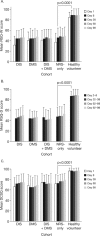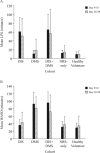Nonrestorative sleep as a distinct component of insomnia
- PMID: 20394313
- PMCID: PMC2849783
- DOI: 10.1093/sleep/33.4.449
Nonrestorative sleep as a distinct component of insomnia
Abstract
Study objectives: Explore characteristics of nonrestorative sleep (NRS) in prospectively defined subgroups of individuals with NRS symptoms, investigate whether NRS can occur independently of difficulties initiating and maintaining sleep (DIS/DMS), and determine its effect on waking function.
Design: Cross-sectional and longitudinal population-based study comparing patterns of daytime symptoms, and their persistence, in cohorts of subjects with NRS symptoms grouped according to presence or absence of DIS and DMS.
Setting: 28 sleep centers in the US.
Participants: Subjects reporting awakening unrestored or unrefreshed at least 3 times weekly over the previous 3 months were classified, based on self-reported sleep problems, to DIS (n = 138), DMS (n = 44), DIS+DMS (n = 125), and NRS-only (no DIS or DMS; n = 192) cohorts. Eighty healthy volunteers formed a control group.
Interventions: None.
Measurements and results: Polysomnography confirmed DIS and/or DMS in 56/138 (41%), 18/44 (41%), and 37/125 (30%) subjects in DIS, DMS, and DIS+DMS cohorts, respectively; and absence of DIS or DMS in 115/192 (60%) NRS-only subjects and 52/80 (65%) healthy volunteers. Multiple subject-reported endpoints including the Endicott Work Productivity Scale, Pittsburgh Insomnia Rating Scale, Restorative Sleep Questionnaire, and SF-36, showed that NRS-only subjects had significantly impaired daytime function relative to healthy volunteers, comparable to impairment affecting subjects with DIS and/or DMS. Symptoms persisted over 3 months.
Conclusions: This study confirms that NRS can occur independently of other components of insomnia. Daytime symptoms were as severe in individuals with NRS-only as those whose NRS symptoms were combined with DIS or DMS.
Figures





Comment in
-
Nonrestorative sleep: have we finally found it?Sleep. 2010 Apr;33(4):417-8. doi: 10.1093/sleep/33.4.417. Sleep. 2010. PMID: 20394307 Free PMC article. No abstract available.
Similar articles
-
Development and evaluation of a measure to assess restorative sleep.J Clin Sleep Med. 2014 Jul 15;10(7):733-41, 741A-741E. doi: 10.5664/jcsm.3860. J Clin Sleep Med. 2014. PMID: 25024650 Free PMC article. Clinical Trial.
-
Nighttime insomnia symptoms and perceived health in the America Insomnia Survey (AIS).Sleep. 2011 Aug 1;34(8):997-1011. doi: 10.5665/SLEEP.1150. Sleep. 2011. PMID: 21804662 Free PMC article.
-
DSM-IV psychiatric comorbidity according to symptoms of insomnia: a nationwide sample of Korean adults.Soc Psychiatry Psychiatr Epidemiol. 2012 Dec;47(12):2019-33. doi: 10.1007/s00127-012-0502-0. Epub 2012 Apr 13. Soc Psychiatry Psychiatr Epidemiol. 2012. PMID: 22526822 Clinical Trial.
-
Nonrestorative sleep.Sleep Med Rev. 2008 Aug;12(4):275-88. doi: 10.1016/j.smrv.2007.12.002. Epub 2008 Jun 6. Sleep Med Rev. 2008. PMID: 18539057 Review.
-
Measurement of non-restorative sleep in insomnia: A review of the literature.Sleep Med Rev. 2010 Jun;14(3):205-12. doi: 10.1016/j.smrv.2009.10.002. Epub 2009 Dec 16. Sleep Med Rev. 2010. PMID: 20018533 Review.
Cited by
-
Nonrestorative sleep: have we finally found it?Sleep. 2010 Apr;33(4):417-8. doi: 10.1093/sleep/33.4.417. Sleep. 2010. PMID: 20394307 Free PMC article. No abstract available.
-
Therapeutic efficacy of zolpidem combined with cognitive-behavioral therapy on primary insomnia.Medicine (Baltimore). 2019 Sep;98(39):e17122. doi: 10.1097/MD.0000000000017122. Medicine (Baltimore). 2019. PMID: 31574811 Free PMC article.
-
Exploring the short-term influence of a proprietary oil extract of black cumin (Nigella sativa) on non-restorative sleep: a randomized, double-blinded, placebo-controlled actigraphy study.Front Nutr. 2024 Jan 15;10:1200118. doi: 10.3389/fnut.2023.1200118. eCollection 2023. Front Nutr. 2024. PMID: 38288065 Free PMC article.
-
Associations of social isolation and loneliness with the onset of insomnia symptoms among middle-aged and older adults in the United States: A population-based cohort study.Psychiatry Res. 2023 Jul;325:115266. doi: 10.1016/j.psychres.2023.115266. Epub 2023 May 24. Psychiatry Res. 2023. PMID: 37245484 Free PMC article.
-
New perspectives on the role of melatonin in human sleep, circadian rhythms and their regulation.Br J Pharmacol. 2018 Aug;175(16):3190-3199. doi: 10.1111/bph.14116. Epub 2018 Jan 15. Br J Pharmacol. 2018. PMID: 29318587 Free PMC article. Review.
References
-
- American Psychiatric Association. Diagnostic and statistical manual of mental disorders. 4th ed. Arlington, VA: American Psychiatric Publishing Inc.; 1994.
-
- Ohayon MM. Prevalence and correlates of nonrestorative sleep complaints. Arch Intern Med. 2005;165:35–41. - PubMed
-
- Stone KC, Taylor DJ, McCrae CS, Kalsekar A, Lichstein KL. Nonrestorative sleep. Sleep Med Rev. 2008;12:275–88. - PubMed
-
- Moldofsky H. Nonrestorative sleep and symptoms after a febrile illness in patients with fibrositis and chronic fatigue syndromes. J Rheumatol Suppl. 1989;19:150–3. - PubMed
Publication types
MeSH terms
LinkOut - more resources
Full Text Sources
Other Literature Sources
Medical

